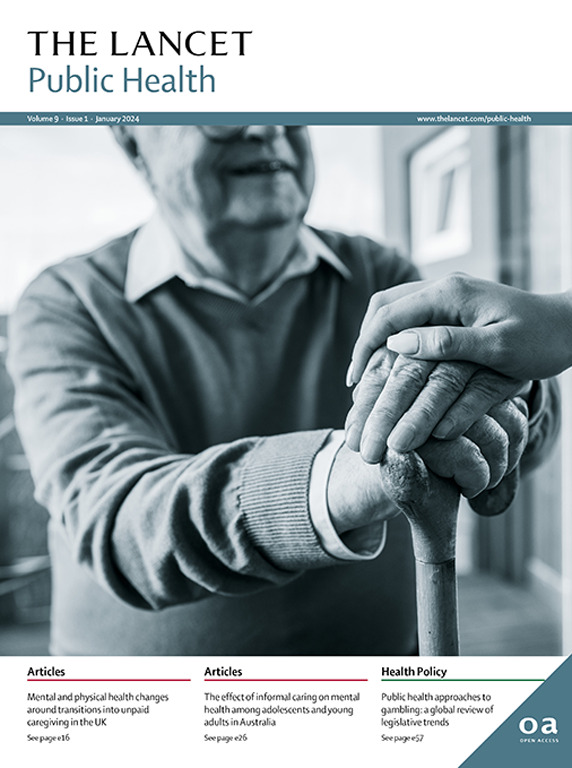Contemporary epidemiology of hospitalised heart failure with reduced versus preserved ejection fraction in England: a retrospective, cohort study of whole-population electronic health records
IF 25.4
1区 医学
Q1 PUBLIC, ENVIRONMENTAL & OCCUPATIONAL HEALTH
引用次数: 0
Abstract
Background
Heart failure is common, complex, and often associated with coexisting chronic medical conditions and a high mortality. We aimed to assess the epidemiology of people admitted to hospital with heart failure with reduced ejection fraction (HFrEF) and heart failure with preserved ejection fraction (HFpEF), including the period covering the COVID-19 pandemic, which was previously not well characterised.Methods
In this retrospective, cohort study, we used whole-population electronic health records with 57 million individuals in England to identify patients hospitalised with heart failure as the primary diagnosis in any consultant episode of an in-patient admission to a National Health Service (NHS) hospital. We excluded individuals with less than 1 year of medical history records in primary or secondary care; admissions to NHS hospitals for which less than 10% of heart failure cases were linkable to the National Heart Failure Audit (NHFA); individuals younger than 18 years at the time of the heart failure hospitalisation; and patients who died in hospital during the index heart failure admission. For patients with new onset heart failure, we assessed incidence rates of 30-day and 1-year all-cause and cause-specific (cardiovascular, non-cardiovascular, and heart failure-related) emergency rehospitalisation and mortality after discharge, and dispensed guideline-recommended medical therapy (GRMT). Follow-up occurred from the index admission to the earliest occurrence of the event of interest, death, or end of data coverage. We estimated adjusted hazard ratios (HRs) to compare HFrEF with HFpEF. We computed population-attributable fractions to quantify the percentage of outcomes attributable to coexisting chronic medical conditions.Findings
Among 233 320 patients identified who survived the index heart failure admission across 335 NHS hospitals between Jan 1, 2019, and Dec 31, 2022, 101 320 (43·4%) had HFrEF, 71 910 (30·8%) had HFpEF, and 60 090 (25·8%) had an unknown classification. In patients with new onset heart failure, there were reductions in all-cause 30-day (–5·2% [95% CI –7·7 to –2·6] in 2019–22) and 1-year rehospitalisation rates (–3·9% [–6·6 to –1·2]). Declining 30-day rehospitalisation rates affected patients with HFpEF (–4·8% [–9·2 to –0·2]) and HFrEF (–6·2% [–10·5 to –1·6]), although 1-year rates were not statistically significant for patients with HFpEF (–2·2% [–6·6 to 2·3] vs –5·7% [–10·6 to –0·5] for HFrEF). There were no temporal trends in incidence rates of 30-day or 1-year mortality after discharge. The rates of all-cause (HR 1·20 [1·18–1·22]) and cause-specific rehospitalisation were uniformly higher in those with HFpEF than those with HFrEF. Patients with HFpEF also had higher rates of 1-year all-cause mortality after discharge (HR 1·07 [1·05–1·09]), driven by excess risk of non-cardiovascular death (HR 1·25 [1·21–1·29]). Rates of rehospitalisation and mortality were highest in patients with coexisting chronic kidney disease, chronic obstructive pulmonary disease, dementia, and liver disease. Chronic kidney disease contributed to 6·5% (5·6–7·4) of rehospitalisations within 1 year for HFrEF and 5·0% (4·1–5·9) of rehospitalisations for HFpEF, double that of any other coexisting condition. There was swift implementation of newer GRMT, but markedly lower dispensing of these medications in patients with coexisting chronic kidney disease.Interpretation
Rates of rehospitalisation in patients with heart failure in England have decreased during 2019–22. Further population health improvements could be reached through enhanced implementation of GRMT, particularly in patients with coexisting chronic kidney disease, who, despite being at high risk, remain undertreated.Funding
Wellcome Trust, Health Data Research UK, British Heart Foundation Data Science Centre.英格兰射血分数降低与保留的住院心力衰竭的当代流行病学:全人群电子健康记录的回顾性队列研究
背景心力衰竭是一种常见、复杂的疾病,通常与并存的慢性疾病和高死亡率相关。我们旨在评估射血分数降低型心力衰竭(HFrEF)和射血分数保留型心力衰竭(HFpEF)入院患者的流行病学情况,其中包括 COVID-19 大流行期间的情况,而这一流行病的特征在以前并不明确。方法在这项回顾性队列研究中,我们使用了英格兰 5700 万人的全人群电子健康记录,以确定在国民健康服务(NHS)医院住院的任何顾问病例中以心力衰竭为主要诊断入院的患者。我们排除了在初级或中级医疗机构中病史记录不足一年的患者;入院的 NHS 医院中与国家心衰审计(NHFA)相关联的心衰病例不足 10% 的患者;心衰住院时年龄不足 18 岁的患者;以及在心衰住院期间在医院死亡的患者。对于新发心衰患者,我们评估了出院后30天和1年全因和特定病因(心血管、非心血管和心衰相关)急诊再住院率和死亡率,以及指南推荐的药物治疗(GRMT)配药率。随访时间从指数入院开始,直至最早发生相关事件、死亡或数据覆盖结束。我们估算了调整后的危险比(HRs),以比较 HFrEF 和 HFpEF。研究结果在2019年1月1日至2022年12月31日期间,335家英国国家医疗服务系统(NHS)医院共确认了233320名心衰入院指标存活患者,其中101320人(43-4%)为HFrEF,71910人(30-8%)为HFpEF,60090人(25-8%)分类不明。在新发心衰患者中,全因 30 天(2019-22 年为-5-2% [95% CI -7-7 to -2-6])和 1 年再住院率(-3-9% [-6-6 to -1-2] )均有所下降。HFpEF(-4-8% [-9-2 to -0-2])和HFrEF(-6-2% [-10-5 to -1-6] )患者的30天再住院率下降,但HFpEF患者的1年再住院率并无统计学意义(-2-2% [-6-6 to 2-3] vs HFrEF -5-7% [-10-6 to -0-5])。出院后 30 天或 1 年的死亡率没有时间趋势。HFpEF患者的全因(HR 1-20 [1-18-1-22])和特定病因再住院率均高于HFrEF患者。HFpEF 患者出院后 1 年的全因死亡率(HR 1-07 [1-05-1-09])也较高,这主要是由于非心血管死亡风险过高(HR 1-25 [1-21-1-29])。同时患有慢性肾病、慢性阻塞性肺病、痴呆症和肝病的患者再次住院率和死亡率最高。慢性肾脏疾病导致 6-5%(5-6-7-4)的 HFrEF 患者在 1 年内再次住院,5-0%(4-1-5-9)的 HFpEF 患者再次住院,是其他并存疾病的两倍。较新的GRMT得到了迅速实施,但同时患有慢性肾脏病的患者中,这些药物的配发率明显降低。通过加强GRMT的实施,可以进一步改善人口健康状况,尤其是合并慢性肾脏病的患者,尽管他们的风险很高,但治疗仍然不足。
本文章由计算机程序翻译,如有差异,请以英文原文为准。
求助全文
约1分钟内获得全文
求助全文
来源期刊

Lancet Public Health
Medicine-Public Health, Environmental and Occupational Health
CiteScore
55.60
自引率
0.80%
发文量
305
审稿时长
8 weeks
期刊介绍:
The Lancet Public Health is committed to tackling the most pressing issues across all aspects of public health. We have a strong commitment to using science to improve health equity and social justice. In line with the values and vision of The Lancet, we take a broad and inclusive approach to public health and are interested in interdisciplinary research.
We publish a range of content types that can advance public health policies and outcomes. These include Articles, Review, Comment, and Correspondence. Learn more about the types of papers we publish.
 求助内容:
求助内容: 应助结果提醒方式:
应助结果提醒方式:


